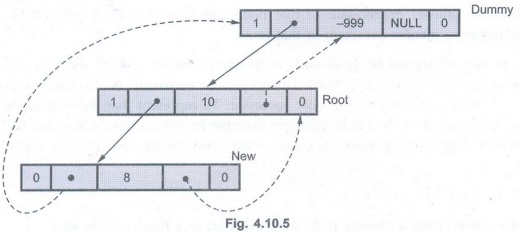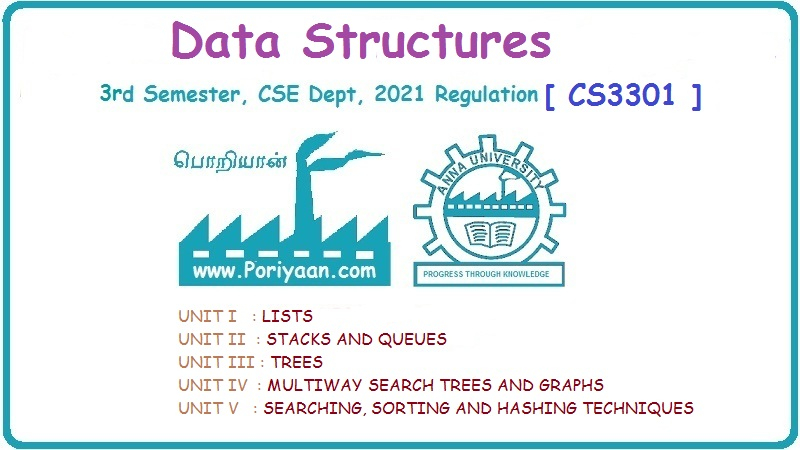Data Structure: Unit III: Trees
Threaded Binary Trees
Operations, Structure, Algorithm with Example C Programs, Advantages, Disadvantage | ADT Data Structure
In threaded binary tree the leaf nodes are having the NULL values in the left and right link fields. It is just a wastage of memory.
Threaded Binary Trees
In
threaded binary tree the leaf nodes are having the NULL values in the left and
right link fields. It is just a wastage of memory. So to avoid the NULL value
the threads are used. The threads are nothing but the links to predecessor and
successor nodes.

There
are three types of threading possible - Inorder, preorder and postorder
threading.
C structure
typedef
struct thread
{
int
data;
int
lth,rth;
struct
thread *left;
struct
thread *right;
}Th;
The
basic idea in inorder threading is that the left thread should point to the
predecessor and the right thread points to the successor. Here we are assuming
the head node as the starting node and the root node of the tree is attached to
left of head node which is as shown in Fig. 4.10.1.
Let us
see the 'C' program for the creation of threaded binary tree.
/*****************************************************************
Program
for Implementation of Inorder Threaded Binary Search Tree and perform
insertion, deletion and display of tree.
*****************************************************************/
#include<stdio.h>
#include<conio.h>
#include
<alloc.h>
typedef
struct bst
{
int
data;
int lth,
rth;
struct
bst *left, *right;
}node;
node
*dummy;
/*
------------------------------------------------------------------------------------------
The main
function
------------------------------------------------------------------------------------------
*/
void
main()
{
int
choice,key;
char
ans='N';
node
*root, *temp, *parent;
node
*create(node *),*search(node*, int,node**);
void
inorder(node *),del(node*,int);
clrscr();
do
{
clrscr();
printf("\n\t
Program For Threaded Binary Tree");
printf("\n1.Create
\n2.Display \n3.Search \n4.Delete");
scanf("%d",
&choice);
switch(choice)
{
case
1:root = NULL;
do
{
root=create(root);
printf("\n
Do u Want To enter More
Elements?(y/n)");
ans=getch();
}
while(ans =='y');
break;
case
2:if(root == NULL)
printf("Tree
Is Not Created");
else
{
printf("\n
The Tree is: ");
inorder(root);
}
break;
case
3:printf("\n Enter The Element Which You Want To Search");
scanf("%d",&key);
temp=search(root,key,&parent);
if(temp==
NULL)
printf("\nElement
is Not Present");
else
printf("Its
Parent Node is %d",parent->data);
break;
case
4:printf("\n Enter The Element U wish to Delete");
scanf("%d",
&key);
del(root,key);
break;
}
printf("\n\nWant
To See Main Menu?(y/n)");
ans=getche()*
}
while(ans=='y');
}
/*
------------------------------------------------------------------------------------------
The
create function
------------------------------------------------------------------------------------------
*/
node
*create(node *root)
{
void
insert(node *,node *);
node
*New;
New = (node*)malloc(sizeof(node));
New->left=NULL;
New->right=NULL;
New->lth=0;
New->rth=0;
printf("\n
Enter The Element ");
scanf("%d",
&New->data);
if(root
== NULL)
{ //
Tree is not Created
root=New;
dummy =
(node*)malloc(sizeof(node));
dummy->data=-999;
dummy->left=root;
root->left-dummy;
root->right-dummy;
}
else
insert(root,New);
return
root;
}
/*
------------------------------------------------------------------------------------------
This
function is for creating a binary search tree
------------------------------------------------------------------------------------------
*/
void
insert(node *root,node *New)
{
if(New->data<root->data)
{
if(root->lth==0)
{
New->left=root->left;
New->right=root;
root->left=New;
root->Ith=1;
}
else
insert(root->left,New);
}
if(New->data>root->data)
{
if(root->rth==0)
{
New->right=root->right;
New->left=root;
root->rth=1;
root->right=New;
}
else
insert(root->right,New);
}
}
/*
------------------------------------------------------------------------------------------
The
search function
------------------------------------------------------------------------------------------
*/
node
*search(node *root,int key,node **parent)
{
node
*temp;
temp=root;
while((temp!=dummy))
{
if(temp->data==key)
{
printf("\n
The %d Element is Present",temp->data);
return
temp;
}
*parent=temp;
if(temp->data>key)
temp-temp->left;
else
temp-temp->right;
}
return
NULL;
}
/*
------------------------------------------------------------------------------------------
This
function is for deleting a node from binary search tree There exists three
possible cases for deletion of a node
------------------------------------------------------------------------------------------
*/
void
del(node *root,int key)
{
node
*temp, *parent,*temp_succ;
node
*search(node *,int,node **);
int
flag=0;
temp=search(root,key,&parent);
if(root==temp)
{
printf("\n
Its Root Node Which Can Not Be Deleted!!");
return;
}
//deleting
a node with two children
if(temp->lth==1&&temp->rth
==1)
{
parent=temp;
temp_succ=temp->right;//Finding
Inorder successor
while(temp_succ->lth==1)
{
flag=1;
parent=temp_succ;
temp_succ=temp_succ->left;
}
if(flag==0)
{
temp->data=temp_succ->data;
parent->right-temp_succ->right;
parent->rth=0;
}
else//inorder
successor is on left subbranch.
// and
it has to be traversed
{
temp->data=temp_succ->data;
parent->rth=0;
parent->lth=0;
parent->left=temp_succ->left;
}
printf("
Now Deleted it!");
return;
}
//deleting
a node having only one child
//The
node to be deleted has left child
if(temp->lth==1
&&temp->rth==0)
{
if(parent->left==temp)
{
(temp->left)->right-parent;
parent->left-temp->left;
}
else
{
(temp->left)->right-temp->right;
parent->right-temp->left;
temp=NULL;
delete
temp;
printf("
Now Deleted it!");
return;
}
//The
node to be deleted has right child
if(temp->lth==0
&&temp->rth!=0)
{
if(parent->left==temp)
{
parent->left=temp->right;
(temp->right)->left-temp->left;
(temp->right)->right=parent;
}
else
{
parent->right-temp->right;
(temp->right)->left=parent;
}
temp=NULL;
free(temp);
printf("
Now Deleted it!");
return;
}
//deleting
a node which is having no child
if(temp->lth==0
&&temp->rth==0)
{
if(parent->left==temp)
{
parent->left-temp->left;
parent->lth=0;
}
else
{
parent->right-temp->right;
parent->rth=0;
}
printf("
Now Deleted it!");
return;
}
}
*/
------------------------------------------------------------------------------------------
The
inorder function
------------------------------------------------------------------------------------------
void
inorder(node *temp)
{
while(temp!=dummy)
{
while(temp->lth==1)
temp-temp->left;
printf("%d",temp->data);
while(temp->rth==0)
{
temp-temp->right;
if(temp==dummy)
return;
printf("%d",temp->data);
}
temp-temp->right;
}
}
Output
Program
For Threaded Binary Tree
1.
Create
2.
Display
3.
Search
4.
Delete 1
Enter
The Element 10
Do u
Want To enter More Elements?(y/n)
Enter The Element 8
Do u
Want To enter More Elements? (y/n)
Enter The Element 7
Do u
Want To enter More Elements? (y/n)
Enter The Element 15
Do u
Want To enter More Elements?(y/n)
Enter The Element 11
Do u
Want To enter More Elements?(y/n)
Enter The Element 17
Do u
Want To enter More Elements? (y/n)
Want To See Main Menu?(y/n)
Program
For Threaded Binary Tree
1.
Create
2.
Display
3.
Search
4.
Delete2
The Tree
is: 7 8 9 10 11 15 17
Want To
See Main Menu?(y/n)
Program
For Threaded Binary Tree
1.Create
2.Display
3.Search
4.Delete3
Enter
The Element Which You Want To Search 11
The 11
Element is PresentIts Parent Node is 15
Want To
See Main Menu?(y/n)
Program For Threaded Binary Tree
1.
Create
2. Display
3.
Search
4.
Delete 4
Enter
The Element U wish to Delete 15
The 15
Element is Present Now Deleted it!
Want To
See Main Menu?(y/n)
Program
For Threaded Binary Tree
1.
Create
2.
Display
3.
Search
4.
Delete2
The Tree
is: 7 8 9 10 11 17
Want To
See Main Menu?(y/n)
Logic explanation for threaded binary tree -
In
thread binary tree, the NULL pointers are avoided. Instead of left NULL pointer
the link points to inorder predecessor of that node. Similarly instead of right
NULL pointer the link points to inorder successor of that node.
There
are two additional fields in each node named as 1th and rth these fields
indicate whether left or right thread is present. Thread present means the NULL
link is replaced by a link to inorder predecessor or inorder successor. To
represent that there exists thread the 1th or rth fields are set to 0. Let us
take one example to explain how a threaded binary tree gets created. Suppose we
want to create a threaded binary tree for the nodes having values,
10, 8,
6, 12, 9, 11, 14
Initially
we will create a dummy node which will act as a header of the tree.

Now let
us take first value i.e. 10. The node with value 10 will be the root node we
will attach this root node as left child of dummy node.

The NULL
links of root's left and right child will be pointed to dummy.

Now next
comes 8. The 8 will be compared with 10, as the value is less than 10, we will
attach 8 as left child of 10 and we will set root's 1th field to 1, indicating
that the node 10 is having left child. See then how the links are arranged.
New → left = root → left
New → right = root;
root → left = New;
root → lth = = 1;

Note
that the left link of node 8 points to its inorder predecessor and right link
of node 8 points to its inorder successor.
Next
comes 6. The value 6 will be first compared with root i.e. with 10. As 6 is
less than 10, we will move on left subbranch. The 6 will then be compared with
8, so we have to move on left subbranch of 8. But Ith of node 8 is 0,
indicating that there is no left child to 8, so we will attach 6 as left child
to 8.

Then
comes 12. We will compare 12 with 10. As 12 is greater than 10, we will attach
the node 12 as right child of 10.

Note
that the left field of node 12 points to its inorder predecessor and right
field of node 12 points to its inorder successor. Thus by attaching 9, 11, 14
as appropriate children, the threaded binary tree will look like this

Such a
threaded tree is called inorder threaded binary tree.
Ex. 4.10.1: Create threaded binary tree for 10,
20, 30, 40, 50.
Sol. :

Advantages of threaded binary trees
1. Due
to NULL links in binary tree certain amount of memory gets wastage. This
wastage of memory is utilized by using threads.
2. The
predecessor and successor of any node can be accessed effectively.
Disadvantage of threaded binary trees
1.
Insertion and deletion of nodes become complex in threaded binary tree, since
thread and link manipulation is required on every insertion.
Ex. 4.10.2 With reference to Fig. 4.10.9 answer
the following
i) Is it a binary tree?
ii) Is it a complete tree?
iii) Give the preoder traversal?
iv) Give the inorder traversal?
v) Give the postorder traversal?
vi) Give list notation (using pairs of round
brackets)
vii) Where will be the left child of node 4
pointing to if it is converted to threaded
viii) Is it a max heap?

Sol. :
i) Yes
it is a binary tree as it consists the nodes with at the most two child nodes.
ii) No
it is not a complete binary tree. The complete binary tree contains 2h + 1-
1 number of nodes, The height of above tree is, h = 2. It contains 6 nodes
instead of 7.
iii) Preorder Traversal 9 8 6
574
iv) Inorder Traversal 6 8 5
974
v) Postorder Traversal 6 58479
vi) List Notation
(Parent, left - subtree, right-subtree)
(9,
(8,6,5), (7,4))
vii) If
the tree is converted to threaded binary tree then the left child of 4 will
point to its predecessor i.e. 7.
viii)
Yes it is a max heap because of two reasons,
i). It
is almost complete binary tree
ii) The
parent node is having greater value than its child nodes.
Review Questions
1. What is threaded binary tree?
Explain right and left in threaded binary tree.
2. What is the advantage of threaded
binary tree over binary tree? Explain threaded binary tree construction with
suitable example.
Data Structure: Unit III: Trees : Tag: : Operations, Structure, Algorithm with Example C Programs, Advantages, Disadvantage | ADT Data Structure - Threaded Binary Trees
Related Topics
Related Subjects
Data Structure
CS3301 3rd Semester CSE Dept | 2021 Regulation | 3rd Semester CSE Dept 2021 Regulation
